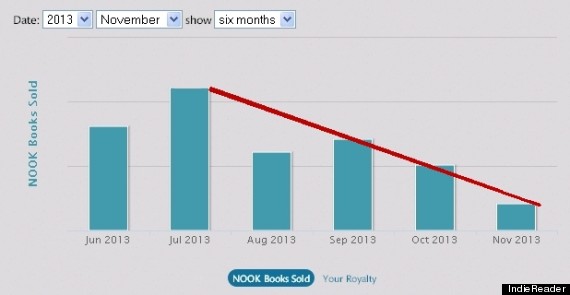By Danny O. Snow for IndieReader:
Does art imitate life, or vice versa?
Back in 1998, we all rooted for the charming little bookshop around the corner, struggling to survive the opening of a megalithic “big box” chain store, in the hit film "You’ve Got Mail." Alas, our lovable little David succumbed to the bookselling Goliath in the movie… as (at the time) did countless indie bookshops, facing ruthless competition from Borders and Barnes & Noble.
Flash forward to 2008: In one day, Borders stock plummeted from around $16 to less than $4 in one day. A few months later, Borders was gone. As the surviving megachain, the stock of Barnes & Noble (NYSE: BKS) was trading around $27 per share by 2009. At that point, many held bright expectations for the future of B&N. Yet by 21 November 2013, its stock closed below $16, with continued speculation of a breakup.
What’s going on? And why might B&N’s current struggles spell good news for those who still love indie booksellers?
The CEO of B&N, William Lynch, resigned in July 2013, as Amazon continued to outpace its brick and mortar rival. This was especially true in the world of e-books and tablet computers, where the Kindle and iPad left B&N’s Nook far behind, in spite of its April launch of Nook Press, a do-it-yourself e-book publishing site for indie writers, which has subsequently fallen short of early expectations.
This month, Barnes & Noble has launched a new holiday ad blitz, featuring television personality Jack McBrayer. The ads tout B&N as a destination for physical books, Nook devices and other popular gift items.
According to Examiner.com, “This new holiday ad campaign appears to be a ‘Hail Mary’ pass for the brick and mortar bookseller, which has been squeezed by online retailers and failed to gain significant traction in the digital books market. The company continues to struggle in hopes of avoiding the same fate as other major retailers of physical media, such as Borders and Blockbuster, which have closed their doors for good in recent months.”
Yet if B&N faces the same gloomy fate, there might be a sunny side for indie bookshops, and readers who love them.
Anecdotal reports suggest that Nook e-book sales have fallen steadily in recent months as Barnes & Noble has struggled. This graph does NOT represent Nook e-book sales overall, but rather only a single publisher’s royalties from 50 +/- titles since June 2013. Of note is the starting point of the decline after July 2013 when B&N’s CEO resigned. If in fact the same pattern applies to publishers generally, it may reflect a growing discomfort by consumers to buy products from a bookseller whose future is uncertain. Whether B&N can turn things around this holiday season is a question that remains open.
According to a 2011 report in the New Orleans Times-Picayune, “The last two years we have certainly seen an increase in our membership, which is one way we can gauge the strength of the independent bookstores,” said Meg Zelickson Smith, a spokeswoman for the American Booksellers Association. “Until [2010] the association’s membership [had] declined for 10 to 15 years,” she said. By 2011, ABA membership had grown to 1,512 member companies in 1,823 locations. In 2013, the number has grown to 1,632 companies in 1,971 locations.
Completing the circle, in 2014 it may be that the tables have turned from the plot of "You’ve Got Mail." As brick and mortar megachains appear to be fading from the landscape of the book world, indie booksellers are enjoying renewed patronage from readers who prefer to shop locally, want a sense of community often absent in the “big box” world, or simply enjoy reading material more eclectic than typical mass-market fare.
While the question of whether their current momentum is enough to shield indie bookshops from the juggernaut of online bookselling giants remains open, there is every indication that the “little shop around the corner” could enjoy a banner holiday season in 2013, and start the new year ahead with a bright outlook.
For more from IndieReader, click here!
Our 2024 Coverage Needs You
It's Another Trump-Biden Showdown — And We Need Your Help
The Future Of Democracy Is At Stake
Our 2024 Coverage Needs You
Your Loyalty Means The World To Us
As Americans head to the polls in 2024, the very future of our country is at stake. At HuffPost, we believe that a free press is critical to creating well-informed voters. That's why our journalism is free for everyone, even though other newsrooms retreat behind expensive paywalls.
Our journalists will continue to cover the twists and turns during this historic presidential election. With your help, we'll bring you hard-hitting investigations, well-researched analysis and timely takes you can't find elsewhere. Reporting in this current political climate is a responsibility we do not take lightly, and we thank you for your support.
Contribute as little as $2 to keep our news free for all.
Can't afford to donate? Support HuffPost by creating a free account and log in while you read.
The 2024 election is heating up, and women's rights, health care, voting rights, and the very future of democracy are all at stake. Donald Trump will face Joe Biden in the most consequential vote of our time. And HuffPost will be there, covering every twist and turn. America's future hangs in the balance. Would you consider contributing to support our journalism and keep it free for all during this critical season?
HuffPost believes news should be accessible to everyone, regardless of their ability to pay for it. We rely on readers like you to help fund our work. Any contribution you can make — even as little as $2 — goes directly toward supporting the impactful journalism that we will continue to produce this year. Thank you for being part of our story.
Can't afford to donate? Support HuffPost by creating a free account and log in while you read.
It's official: Donald Trump will face Joe Biden this fall in the presidential election. As we face the most consequential presidential election of our time, HuffPost is committed to bringing you up-to-date, accurate news about the 2024 race. While other outlets have retreated behind paywalls, you can trust our news will stay free.
But we can't do it without your help. Reader funding is one of the key ways we support our newsroom. Would you consider making a donation to help fund our news during this critical time? Your contributions are vital to supporting a free press.
Contribute as little as $2 to keep our journalism free and accessible to all.
Can't afford to donate? Support HuffPost by creating a free account and log in while you read.
As Americans head to the polls in 2024, the very future of our country is at stake. At HuffPost, we believe that a free press is critical to creating well-informed voters. That's why our journalism is free for everyone, even though other newsrooms retreat behind expensive paywalls.
Our journalists will continue to cover the twists and turns during this historic presidential election. With your help, we'll bring you hard-hitting investigations, well-researched analysis and timely takes you can't find elsewhere. Reporting in this current political climate is a responsibility we do not take lightly, and we thank you for your support.
Contribute as little as $2 to keep our news free for all.
Can't afford to donate? Support HuffPost by creating a free account and log in while you read.
Dear HuffPost Reader
Thank you for your past contribution to HuffPost. We are sincerely grateful for readers like you who help us ensure that we can keep our journalism free for everyone.
The stakes are high this year, and our 2024 coverage could use continued support. Would you consider becoming a regular HuffPost contributor?
Dear HuffPost Reader
Thank you for your past contribution to HuffPost. We are sincerely grateful for readers like you who help us ensure that we can keep our journalism free for everyone.
The stakes are high this year, and our 2024 coverage could use continued support. If circumstances have changed since you last contributed, we hope you'll consider contributing to HuffPost once more.
Already contributed? Log in to hide these messages.

